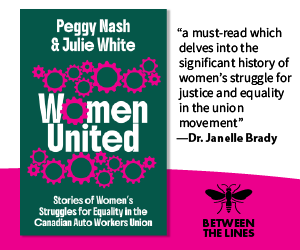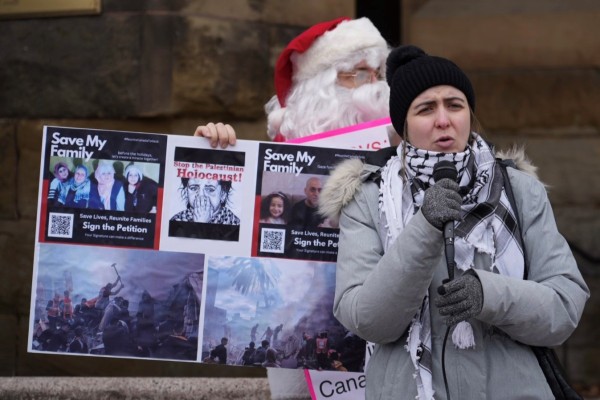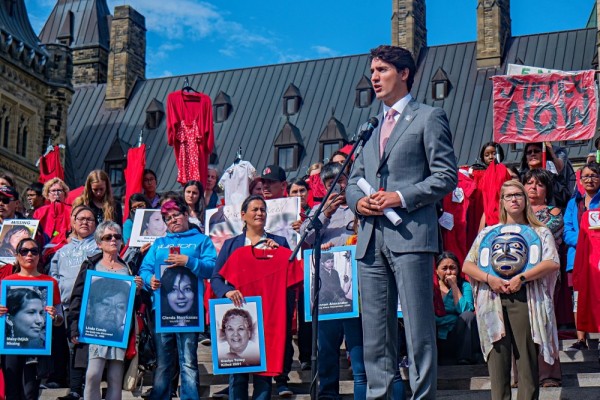The new Canadian militarism
Canada’s growing militarism is evident not only in state structures but also in the institutions and rituals of civil society

From the Conversion of Highway 401 entering Toronto into the “Highway of Heroes” as a macabre celebration of Canadian soldiers killed in combat, to the renaming of the Canadian armed forces to echo past imperialist campaigns, to the wrapping of Hockey night in Canada in nationalist celebration of the military, the themes of militarism now penetrate the cultural experiences of daily life. In what should be a period of sober reflection on the horrors of war, and a history lesson on the imperialist conflagration which produced it, the centenary since the start of the First World War has become an occasion for the glorification of Canadian militarism in the making of the nation and the national identity.
The former national storyline of Canada as peace- keeping nation, carefully constructed by the Liberals from Lester Pearson to Jean Chrétien, is now in total disarray. But this has also opened political space for unpacking and interrogating the history of Canadian imperialism, and its economic form and political modalities today. A remarkable series of books — Jamie Swift and Ian McKay’s Warrior Nation, Jerome Klassen’s Joining Empire, James Daschuk’s Clearing the Plains, and Todd Gordon’s Imperialist Canada being the foremost examples — have begun to tell a powerful, often chilling, counter-narrative of Canada’s past and current roles in land grabs and world affairs. The theoretical writings of Sandra Whitworth and Colleen Bell, and the steady flow of critical journalistic forays by Yves Engler, Anthony Fenton and Steven Staples, have provided a quite different lens from which to view Canadian foreign policy and militarism. These efforts build on the steady diet of alternative accounts of Canada’s place in the imperialist chain in Canadian Dimension over 50 years. They place in perspective Canada’s embrace of a new militarism.
The Afghanistan war and after
Canada’s military deployment to Afghanistan, as part of the US-led Operation Enduring Freedom, was central to the transformation from its beginning in 2001. it is now the commonly accepted view that the Afghanistan War, including the Canadian mission with its 3D approach (diplomacy, defence, development), was, at best, a disappointment. In the reflections that came with the “formal” withdrawal of Canadian troops from combat positions this year, the Globe and Mail’s leading columnist on international affairs, Doug Saunders, openly queried whether the war was “a costly failure” while the Star’s Thomas Walkom more directly declared it “a pointless war.” The sustained analyses that have came from the Afghanistan Analysts network have drawn the same conclusion, and the most senior foreign journalist in the region, Patrick Cockburn, has called the more than dozen years of NATO intervention in Afghanistan a “fiasco.” Despite the military impasse, it is still not clear what the actual claims for withdrawal for NATO and its constituent combat- ants amount to. The US retains a commitment to Afghanistan for the longer term, and this implies only a partial withdrawal of armed forces. NATO, too, has not shed all its obligations towards Afghanistan. And it remains unclear the degree to which Canadian troops will be backing up the military trainers and support personnel remaining in Kabul into the future.
In spite of the debacle of the Afghanistan expedition, the Canadian state under Harper has upped commitments to the employment of military force in foreign policy. To begin with even a modest list: the continued military obligations in Haiti and Afghanistan; the bombing of Libya; the unparalleled support for Israel, including the horrific assault on Gaza, that even outstrips the US in the defence of the occupation and ethnic cleansing of Palestine; Canada’s role in the efforts to expand military supports along the Pacific Coast in conjunction with the American pivot towards Asia; the militarization of the Arctic; the strategy to expand Canadian military bases in various parts of the Global South; the covert efforts to destabilize Venezuela, among others.
In two recent flashpoints, Canada has been in the front of the secondary powers making military commitments. In the conflict in the Ukraine prompted by NATO’s efforts to expand its geographical zone, Canada adopted the most belligerent diplomatic stance against Russia and in favour of NATO actions. Canadian troops and CF-18 fighter jets have been moved into offensive positions in Eastern Europe. In the escalating American coalition intervention against the Islamic State in Syria and Iraq, Canada has committed 700 armed personnel, CF-18s, and an assortment of other aircraft and arms for as long as six months (although no one expects that date to hold).
There has been only minor parliamentary dissent to either mission. The opposition vote against the Syrian action from the NDP and Liberals pivoted around demands for clearer plans to be laid out and increased humanitarian assistance. There is absolutely no intent in either case to encourage extra-parliamentary anti-war campaigning. Apart from the opposition registered by Québec Solidaire, across all levels of the Canadian state there is silence from parliamentary representatives. And except for the sporadic challenges from a few columnists, the mass media is again filled with the mix of bluster and obligation of Canada as dependable member of the “international community” to act as an important strut in the war effort.
Neoliberal capitalism and endless war
The burgeoning militarism of the Canadian state needs to be set in the current geopolitical correlation of forces. It is all too easy to cast stones at the Harper regime. But this would leave to the side the Liberal charge into Afghanistan and their construction of the post-9/11 security state; and would ignore the NDP’s embrace of NATO, lack of an alternative defence strategy, and passive acceptance of the new framework of Canada’s military and foreign policies.
First, since the 1980s, the world market has been characterized by a pattern of uneven interdependence. On the one side, the dramatic end to the divisions of the Cold War, and the ascendancy of China and other “emerging” markets, have led to new nodes of economic and political power. On the other, the US has reasserted its preeminence at the centre of the world economy as Japan and Europe remain locked in lasting stagnation. In this geopolitical space, the American-led project of neoliberal globalization emerged and an all-but-impenetrable hegemony over the institutions of world order. This global architecture has facilitated the internationalization of capital into new spheres of circulation and zones, from novel commodity chains to unprecedented financialization, from Vietnam to Turkey. As a consequence, the competitive rivalry between particular labour processes and zones is offset by the interdependence of capital for investment and markets. There is an “internalization” of foreign capital within national power blocs and the economic imperative for political coordination between the central imperialist states, including Canada. This is the basis in which the US, as the unrivalled superpower, has molded its “informal empire” and used such international state modalities as the IMF, World Bank, G7, the UN Security Council and so forth.
Since the arms buildup under Reagan in the making of the Second Cold War in the 1980s, the re-establishment of US supremacy in the world market has gone hand in hand with the reassertion of US military preeminence. A new military logic also emerged: just as the international economic agencies were pursuing the market disciplines of neoliberal structural adjustment policies, the American military and covert apparatuses were vigorously imposing the disciplines of armed force to bring states attempting various nationalist and collectivist economic options, from South America to the Middle East to Asia, into the global market. The military doctrines of American supremacy gained a powerful voice in the Clinton administration’s trumpeting of globalization as historical destiny of American-style liberal democracy.
These doctrines provided a new guidance for NATO and NORAD with the end of the Cold War. They were worked out in practice through the first Iraq war and the intervention to break up Yugoslavia in the 1990s. Canadian forces played a direct combat role in the first, and indirectly through the means by which peacekeeping forces were deployed in the second. Over the various conflicts of the 1990s, the Canadian state adapted to the new form of disciplinary militarism, and began adjusting its arms purchases and positioning strategies for troops accordingly. As a key ally of the US and an important secondary imperialist power in its own right, imperial security as the US defined it also became the cornerstone for Canadian security.
Second, the reconfiguring of the interstate system could not have been achieved apart from the operational capacities of the American state. But it also could not have taken place without a restructuring within national states and, in particular, of their foreign policy and coercive apparatuses. If this began in steps with the Second Cold War and the imperialist wars of discipline of the 1990s, it took on a more thoroughgoing authoritarian and militarist cast with the War on Terror, and as backed by successive Liberal and Conservative regimes. Even a cursory tally of the reorganization of these branches is startling: the Anti-Terrorism Act; the Canada international Security Policy; the international policy statements of the mid-2000s; the Security and Prosperity Partnership and the Fortress north America strategy; the Smart Borders Smart Regulation initiatives; the shifting of military doctrines and arms purchases to support networked “joint capabilities” with operational capacities for “multi-force, multi-country” operations; the rebuilding of the Canadian Airborne regiment and the extension of the JTF2 special forces capacity; the creation of Public Safety Canada and the Canadian Border Services Agency; the extension of the surveillance capacities and reach of CSiS, the RCMP and urban police forces; the reconsideration of the anti-ballistic missile defence system; the militarization of the Arctic; the plans to build seven forward military bases across the Global South; the Canada First Defence Strategy to upgrade military equipment and combat readiness, and many others.
Third, the fourth great crisis of capitalism triggered by the financial meltdown of 2008 has added to the hardening of the state and the new militarism. The emergency bailout of the financial system lingers on in an exceptional monetary policy pumping liquidity into the system, but fiscal policy has mutated into a phase of cutbacks, privatizations and “permanent austerity.” As soon as a “Keynesian moment” of stimulus to stench the recessionary spiral, the major international economic agencies talked about 15 to 20 years of austerity. The much discussed recent report from the OECD, Policy Challenges for the Next 50 Years (PDF), draws an endless horizon for restraint and neoliberalism.
The policy regime of the crisis has further rein-forced the legal and operational capacities of the state to monitor and control dissent. An alarming instance was Bill 78 passed in Québec during the student strike restricting freedom of assembly, protest and picketing. But there is a pattern of new measures being adopted across the core capitalist states. They increase police powers to infiltrate pro- test movements, militarize policing in terms of equipment and techniques and restrict the democratic freedoms underpinning dissent.
Militarism and the anti-war movement
The world has entered a very dangerous political conjuncture. Hard right political forces have been gaining ground, from India and Japan to France and the Ukraine. These forces are gaining further prominence in the Republican Party in the US and the Conservative Party in Canada. The emerging geopolitical strategy of NATO and the central imperialist states is premised on “endless war.” The relative resources and power of the military and coercive branches of the state, especially in a period when the fiscal policy regime is stamped with the mandate of austerity, will almost certainly grow.
Some 100 years ago, as the militarist forces of Europe began to marshal, Rosa Luxemburg published The Accumulation of Capital. in it, she warned of the role that military spending (often in support of imperialist land grabs and dispossessions) played in sustaining effective demand in phases of economic crisis in capitalist societies. It is a political imperative to revisit her arguments. The colonial occupations and dispossessions of the Aboriginal peoples made militarism a founding political structure of the Canadian state. From the Hyde Park Declaration of 1941 and the Defence Produce Sharing Agreement of 1956, through to the defence development sharing and provisions of NAFTA, the Canadian production system has been integrated with the US armaments industry. Weapons production is now, perhaps, the most dynamic manufacturing sector in Canada.
It hardly could be more important today for the Canadian and Québec peace movements to dissect coolly the mystifications surrounding Canada’s place in the world order. The anti-war movements have a pressing—indeed, indispensible—role to play in the opposition to the heightening imperialism and militarism of the Canadian state and capitalism.
This article is based on a talk given on August 23 on behalf of the Canadian Peace Alliance at the People’s university jointly organized by Les Nouveaux Cahiers du Socialisme and Canadian Dimension at the Peoples’ Social Forum in Ottawa.
This article appeared in the November/December 2014 issue of Canadian Dimension (The New Face of Canadian Militarism).










